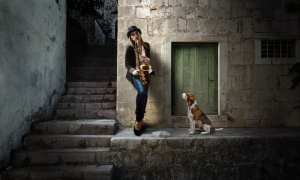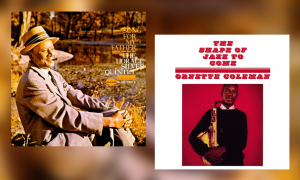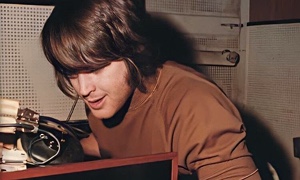Home » Jazz Articles » Building a Jazz Library » Instrumental Duos
Instrumental Duos

Courtesy Karl Ackermann
The New Orleans bands were supplanted by the "hot" quintets, sextets, and septets. Swing ensembles then dominated through the 1930s up to the bebop movement. Duo breakouts existed within the performances early on, but duo recordings were a rarity. Through Bruce Raeburn, Curator Emeritus at Hogan Archive of New Orleans Music and New Orleans Jazz, I learned that cornetist Joe King Oliver and pianist Jelly Roll Morton recorded duo versions of Morton's "Tom Cat Blues" and "King Porter Stomp" in 1924. Many years later, the Verve label re-released a number of Oscar Peterson duo albums in a three-disc set Debut: The Clef/Mercury Duo Recordings 1949-1951 (2009). With bassists Ray Brown and Major Holley, the recordings were Peterson's first in the U.S., and they still sound reasonably fresh after seventy years. Peterson went on to record several duo albums with trumpeters Harry "Sweets" Edison, Roy Eldridge and others. Duke Ellington and bassist Jimmy Blanton released Duo (RCA, 1955), a 45 RPM with four tracks released in Germany.
Full-album duo recordings featuring a vocalist are ubiquitous but instrumental entries didn't take off prior to the Bill Evans and Jim Hall album Undercurrent (United Artists, 1962). The 1970s brought a plethora of duo recordings that moved beyond the conventional, John Coltrane and Rashied Ali's Interstellar Space (ABC Impulse!, 1974) breaking the mold. Double Exposure (Muse, 1977) featured drummer/pianist Joe Chambers and organist Larry Young, who doubled on synthesizer. The George Coleman and Tete Montiliu album Meditation (Timeless, 1977), Tommy Flanagan/Hank Jones' Our Delights (Galaxy, 1978) and One in Two -Two in One (Hathut, 1979) with Max Roach and Anthony Braxton were innovative for their time. Taken as a whole, these albums represent an eclectic period of jazz duos that continues today.
 Binker and Moses
Binker and Moses Escape The Flames
Gearbox Records
2020
It's easy to imagine Escape The Flames as Interstellar Space half a century forward. Tenor saxophonist Binker Golding and drummer Moses Boyd represent the best of the latter-day, sax-led British invasion. This live reimagining of the first disc of their double set Journey To The Mountain Of Forever (Gearbox, 2017) is differentiated by the high-octane boost inspired by an enthusiastic audience. The live versions are primal, chimeric, and considerably longer (with one exception).
Binker Golding: saxophone, tenor; Moses Boyd: drums.
 Milford Graves and Bill Laswell
Milford Graves and Bill Laswell The Stone (Back In No Time)
M.O.D. Technologies
2014
The late drummer/percussionist Milford Graves and bassist Bill Laswell both have eclectic catalogs of duo recordings. Laswell's diverse projects run from Algerian vocalist Abdelkader Belkacem to Peter Brötzmann. Graves recorded duo sessions with an equally broad assortment of colleagues including John Zorn, Don Pullen, Andrew Cyrille, and David Murray. Graves and Laswell sometimes performed together at The Stone and in other downtown settings. A synergy developed and morphed into a sound that simmered below the surface and then exploded into unique expressions. The scale of their shared ideas is incomparable, dense, and cutting.
Milford Graves: drums and percussion; Bill Laswell bass.
 Charlie Haden and Hampton Hawes
Charlie Haden and Hampton Hawes As Long as There's Music
Artists House
1978
Two of the most recognizable architects in creative music, Haden and Hawes could plumb the depths of emotional expression. Both ascended serious challenges and had strong ties to gospel and blues traditions. They expressed redemption in musical terms that were personal and frequently moving. As Long as There's Music is often poetic but has its freer moments as well. Two of the pieces are from Ornette Coleman, a couple are standards and the remainder from the duo. Stylistically, Haden and Hawes may not have been the most logical pairing but As Long as There's Music is exceptional nonetheless.
Charlie Haden: bass; Hampton Hawes: piano.
 Pat Metheny and Lyle Mays
Pat Metheny and Lyle Mays As Falls Wichita, So Falls Wichita Falls
ECM
1981
Metheny and collaborator Lyle Mays stepped away from the quartet format for this inspiring collaboration. At more than twenty minutes, the atmospheric, mysterious title track is an overdubbed standout that ebbs and flows, occasionally wandering but finally holding together. The Bill Evans acoustic commemoration, "September Fifteenth," acknowledges the pianist's passing and his influence over both musicians. "Ozark" and "It's for You" couldn't be more different; the former a folky reverie, the latter synthesized, but equally quixotic.
Pat Metheny: electric guitar, acoustic guitars, bass; Lyle Mays: piano, synthesizer, organ, autoharp; Nana Vasconcelos: berimbau, percussion, drums, vocal (5).
 Bobby Kapp and Matthew Shipp
Bobby Kapp and Matthew Shipp Cactus
Northern-Spy Records
2016
After a productive period in the 1960s, drummer Bobby Kapp revived his career at the start of the millennium. Among his later projects was The Fine Wine Trio with pianist Richard Wyands and bassist Gene Perla. The U.S. State Department commissioned the group to tour Africa and Jordan as "Jazz Ambassadors." That music, being decidedly mainstream, did not reflect Kapp's free jazz affinity, having played with the likes of Archie Shepp and much more recently with alto saxophonist Noah Howard on Between Two Eternities (Self-Produced, 2009).
Shipp is a force of nature whose readily identifiable style has made him one of the most notable and recognizable pianists, improvisers, and composers. The two teamed up as half of Kapp's quartet on the excellent (and under-recognized) Themes 4 Transmutation (Self-Produced, 2014) and have now moved on to this outstanding duo outing, Cactus.
The nine-track set opens with "Overture" and finds Shipp taking the time to explore the antecedents and consequences of each facet of the piece. As he does so, Kapp shifts position frequently, sometimes in accord, often in contrast, and eventually utilizing the entire kit to make his distinctive statement. The bluesy motif of "Before" is more organized at the outset but moves into freer territory towards its conclusion. Kapp provides an extended and thundering introduction to "During" before Shipp heads down a path moving from abstraction to lyricism. A standout piece is "Money"; again, featuring a long opening solo from Kapp, this time both complex and nuanced. Shipp's playing here is energetic and expressive, his angular approach softened but not completely exenterated.
Bobby Kapp: drums; Matthew Shipp: piano.
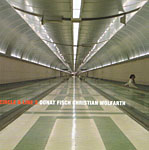 Donat Fisch and Christian Wolfarth
Donat Fisch and Christian Wolfarth Circle & Line 2
Leo Records
2010
Drummer Christian Wolfarth and saxophonist Donat Fisch first recorded in this formation more than ten years ago. Circle & Line 2 is the Swiss duo's reunion and a unique free jazz achievement. It is a challenging format, requiring extraordinary creative effort to maintain variety and interest. When master musicians like Anthony Braxton and Max Roach approached it, the result was an unstructured exchange between very different musical comfort zones. Even when Wolfarth and Fisch released their original Circle & Line (Unit Records) in 1999, it was more in the experimental vein with eighteen short and freer-standing pieces.
Wolfarth utilizes every part of the drum kit but doesn't attempt to throw the whole lot into any of the nine tracks. On "Merlodie," he brushes the cymbals to create an ambient background countering Fisch's blues-influenced lines. "Maria's Blues" is dominated by tom-toms creating a subtle Afro-Latin background that at first contrasts Fisch's long lines before the two seem to absorb each other's sound. Wolfarth supplies a staccato beat from the snare or concentrates on the rim at various points. The collective effect is a diversity of sound responsible for maintaining a high level of interest throughout the set.
Christian Wolfarth: drums; Donat Fisch: tenor and alto saxophones.
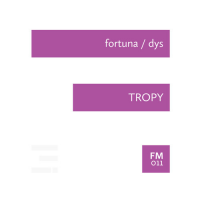 Maciej Fortuna and Krzysztof Dys
Maciej Fortuna and Krzysztof Dys Tropy
Fortuna Music
2014
The American perspective of Polish jazz is principally defined by trumpeter Tomasz Stańko, violinist Michal Urbaniak and pianist Krzysztof Komeda. Along with later arrivals to the scene, such as pianists Marcin Wasilewski and Adam Makowicz and saxophonist Zbigniew Namyslowski, this group of artists constitutes much of what American audiences have experienced in Polish jazz. In Tropy, we have a compelling reason to look toward Poland once again.
The duo of trumpeter Maciej Fortuna and pianist Krzysztof Dys perform original music in an open avant-garde setting with plenty of white space and classical influences. Warm and sensual in approach, there is a sense of mystery mixed with marginal quirkiness that creates a unique atmosphere throughout Tropy. In Fortuna's playing, there are shades of Rob Mazurek and Nate Wooley but Fortuna has his distinct voice. Dys is a multiple award-winning member of several in-country jazz groups as well as an educator. His style is finely developed with touches of Mal Waldron and Keith Jarrett.
Tropy breaks new ground without vehement outbreaks of dissonance; it's far more complicated than interspersing uncontained energy with serenity as though those radical shifts were safe-havens. Instead, Fortuna and Dys have given us a concept of inquisitive beauty; melodic boundaries are left jagged and indefinite. The only sanctuary is in the odd comfort that permeates this collection like a pure organic expression of communication.
Maciej Fortuna: trumpet; Krzysztof Dys: piano.
 Kit Downes and Tomas Challenger
Kit Downes and Tomas Challenger Wedding Music
Loop Records
2013
The multiple-award-winning pianist Kit Downes and the versatile saxophonist Tomas Challenger distinguish one of the most notable releases in Wedding Music. This alliance of these critically praised U.K.'s Loop Collective members has produced a superb and unique collection of duets for church organ and tenor sax. While organ and saxophone duos are a rarity even in the realm of the B-3, Downes and Challenger take it to an altogether different level in this setting.
In recording at Huddersfield University's St Paul's Church, the distinctive space becomes part of the music, creating an acoustic environment where the reverberation and reflection of sound is distinctive in comparison to a studio or stage venue. And then there is the pipe organ with its wind-driven—and somewhat ominous—aural properties, multiple timbres, and various instrumental effects. Downes seems to have a karmic ability to coax the cumbersome apparatus to produce an orchestra-like array of sounds while maintaining a harmonious balance. At times, the sound of the organ is indiscernible from that of the saxophone.
Challenger has demonstrated his resourcefulness to adapt to styles that range from the classically influenced but genre-defying Heritage Orchestra to the improvisational Spy Boy (Babel, 2013). On Wedding Music, he plays long John Coltrane-like lines presenting layers and changing tones while adding spellbinding and reflective qualities to the pieces. Challenger is not verbose even when he reaches for the occasional emotional crescendo. Within his abstract explorations, he is capable of creating a rich and exotic atmosphere without aberrant augmentations.
"Shos" opens the program and sets the stage for all of the pieces on Wedding Music in that it is both hypnotic and ever-shifting. Downes begins "Optics" minimally, and Challenger ethereally floats in, the two musicians imparting a slightly spooky quality to the music. The rapidly pulsing vibrations that Downes gets out of the organ in the opening of "Cooks" are like a subdued pneumatic jackhammer performing a drum roll. If that implies noise, it doesn't play out that way. Like everything that is improvised on Wedding Music, there is a melodic core. Illustrating the diversity of pieces in this collection, the title track's opening is reminiscent of the classic Yes work "Close to the Edge" before it veers off to the more otherworldly setting that feels like home-base for this collection.
Kit Downes: organ; Tom Challenger: saxophone.
 Vijay Iyer and Wadada Leo Smith
Vijay Iyer and Wadada Leo Smith A Cosmic Rhythm With Each Stroke
ECM Records
2016
In the liner notes for A Cosmic Rhythm With Each Stroke, pianist Vijay Iyer notes that he and trumpeter Wadada Leo Smith would often become a sub-segment of the quartet in which the two played. Following their collaboration in New York City in 2015, ECM chief Manfred Eicher brought the two master artists together to make their unique chemistry a matter of record. At its core, the album is a suite dedicated to the late, influential Indian artist Nasreen Mohamedi known for her drawings and photography.
The opening piece, the meditative "Passage," features some of Smith's most expressive playing, with Iyer's augmented chords enriching and expanding the space. The seven-part suite—each movement prefixed by the album title—begins with "All Becomes Alive"; Smith's trumpet soaring and diving to the backdrop of Iyer's electronic drone. Further on, Iyer switches to the piano as he and Smith set into a beautifully soulful groove, an angular turn or two, and a quiet exit. "The Empty Mind Receives" is more conversational with Smith's long phrases countered by Iyer raining down notes. Conveying just what its title suggests, "Labyrinths" is overtly more complex and knottier, while "A Divine Courage" begins with barely audible thumping electronics followed by quiet distances between the sparse trumpet and piano contributions. Eventually, Iyer provides a bass line, resetting the piece to a solid melody. More experimental are "Uncut Emeralds" and "A Cold Fire," with a heavier reliance on electronics on the first and atonality on the latter. The album concludes with a moving tribute to the musician/civil rights activist "Marian Anderson."
Wadada Leo Smith: trumpet; Vijay Iyer: piano, Fender Rhodes, electronics.
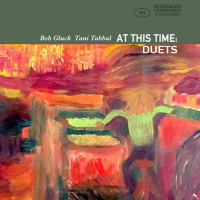 Bob Gluck and Tani Tabbal
Bob Gluck and Tani Tabbal At This Time: Duets
Ictus Records
2017
Bob Gluck is joined by drummer Tani Tabbal whose resume is extraordinary. While still a teenager Tabbal was playing with the Sun Ra Arkestra and went on to work with Roscoe Mitchell, Anthony Braxton, Oliver Lake, Muhal Richard Abrams, Henry Threadgill, Geri Allen, Evan Parker, Dewey Redman and many other notable artists. He had previously released Before Time After (Self-Produced, 2007), his debut as a leader.
The Styne/Cahn standard, "I Fall in Love Too Easily," opens At This Time: Duets in the form of a pleasing Gluck piano solo, his only solo on the recording. A second version of the song is a duet, with Tabbal's light touch taking it from reflective to a bit more triumphant. The Gluck/Tabbal rendition breaks down into fragmented melodies, abstractions, and odd meters, driven by Tabbal's sharp-edged propulsion. "El pueblo Unido jamas sera vencido (The People United Will Never Be Defeated)" is another composition presented in two versions. Written by the Chilean leftist activist Sergio Ortega, the piece was one of several anthems the composer wrote around that political movement. The first version takes a mournful tone, and the second, while it begins in the same vein, takes on a more defiant quality as it progresses.
Four of the nine tracks on At This Time: Duets are co-written by Gluck and Tabbal. "Resolve" and "Persistence" are electronic and drum pieces, both with an organic and spacey feel to them. Tabbal masterfully executes with a touch that blends with Gluck's electronics in a way that makes the two parts a whole sound. At This Time: Duets highlights both cagy and unconventional interplay and subtle atmospherics, and like everything in Gluck's catalog, it is as intriguing as it is listenable.
Bob Gluck: piano, electronics; Tani Tabbal: drums.
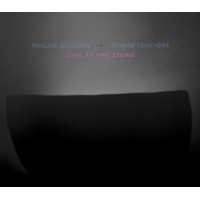 Pauline Oliveros and Connie Crothers
Pauline Oliveros and Connie Crothers Live At the Stone
Important Records
2016
Connie Crothers and Pauline Oliveros both passed away in 2016. Crothers was an accomplished composer, improviser, and pianist; she was not nearly as well-known as she should have been for someone whose talent attracted musical partnerships with Max Roach and Lennie Tristano. Despite playing everywhere from the downtown scene, to Carnegie Hall, to Europe's music halls, her refusal to run parallel to strict lines of free improvisation, avant-garde or mainstream, placed her in a no man's land where others would later follow. Creative music was her strength, and she saw no reason to stifle spontaneity based on arbitrary rubrics.
Pauline Oliveros could be a doppelganger for Crothers if one were to add bellows to the keyboard. An accordionist from early childhood, she was also a pioneer in electronic music and had released several recordings where the output was focused solely on electronics. Only later in her five-decade career did she work to a greater extent with her first instrument of choice. Even more outside the mainstream than Crothers, Oliveros nevertheless influenced a wide range of avant-garde composers, including John Cage and Terry Riley; she performed with Roscoe Mitchell and Susie Ibarra and had composed for Sonic Youth.
Live At the Stone was recorded in 2014 during Crothers' residency at that not-for-profit performance space in the East Village of NYC. It was the only time that Oliveros and Crothers had ever performed together. Captured on this album is a forty-minute extended composition/improvisation titled "First Meeting Still Sounding." Crothers' style of playing is edgy and melodic, and she effortlessly moves from complex, percussive assertion to lyrical passages. Oliveros is subdued with electronics and a bit of wordless vocalizing to augment her accordion. More often than not, the effect is drone-like and nicely compliments Crothers' more sharply defined playing.
Live At the Stone is a fitting tribute to Crothers' many-layered qualities and the extended format allows her the room to move around freely. The pairing with Oliveros provides an intriguing showcase for harmonics and harmonies and plays nicely into Crothers' philosophy that composition and improvisation need not be mutually exclusive.
Pauline Oliveros: accordion, electronic effects, voice; Connie Crothers: piano.
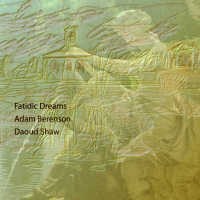 Adam Berenson and Daoud Shaw
Adam Berenson and Daoud Shaw Fatidic Dreams
Self Produced
2018
Fatidic Dreams brings together two musicians whose influences and experiences are as diverse a set of conditions as one could imagine. Philadelphia-area pianist/keyboardist/electronic composer Adam Berenson was a student of Paul Bley at the New England Conservatory of Music, and his musical inspirations run from Beethoven to Zappa. A playwright and teacher, Berenson has recorded across multiple genres, occasionally in the same collection as with his excellent two-disc Lumen (Dream Play, 2014). Percussionist Daoud Shaw's credits include serving as the drummer for The Saturday Night Live Band 1975-1977 (aka Dahaud Shaar), Van Morrison's It's Too Late to Stop Now... (Warner Bros., 1987), the Jerry Garcia Band (1980-1981), and as accompanist to Etta James. Shaw passed away early in 2018.
"Fatidic" is a Latin word that means "prophetic," and with dreams as a window to prophesy, the tracks are designated "Dream 1" through "Dream 13." Berenson's previous duo album Penumbra (Dream Play Records, 2017), with bassist Scott Barnum, is—in Berenson's view—something of a prequel to Fatidic Dreams. "Dream 1," the longest track, is classically informed with the synthesizer filling the orchestration that supports the piano; similar influences materialize in "Dream 6" but with a bit more edge. More dark and ominous, "Dream 2" is also more heavily reliant on effects while being no less musical. The beautiful—and all-acoustic—"Dream 3," the quirky baroque-ness of "Dream 4" and spacy electronics of "Dream 5" are collectively characteristic of the broad stylistic palette employed by Berenson.
Berenson's configurations incorporate jazz, electronica, noise, and chamber music, individually or collectively; all the elements produce a living hybrid sound reflecting a single vision. As he closes out the album, he gives much of "Dream 13" to Shaw's percussive effects, a fitting conclusion to a long-time professional partnership and a farewell. Fatidic Dreams is intelligent and thoughtful, consistently rewarding and adventurous.
Adam Berenson: piano, synthesizers; Daoud Shaw: drums, percussion.
 Don Byron and Aruán Ortiz
Don Byron and Aruán Ortiz Random Dances And (A)Tonalities
Intakt Records
2018
This duo outing features clarinetist and saxophonist Don Byron and pianist Aruán Ortiz. The two gifted composers have been playing together, at Ortiz's initial request, since 2014 but in larger ensembles. In late 2017 Byron and Ortiz met in a studio in Zürich, Switzerland, to record this eclectic set that plays to both artists' broad musical sensibilities.
Random Dances And (A)Tonalities presents Byron and Ortiz deeply involved in a succession of fascinating interchanges. Ortiz wrote three of the ten pieces on the album, and Byron, another pair. "Tete's Dream" opens the album and was written for Ortiz's son. The pianist imposes varying degrees of force while Byron, on clarinet, searches in and around the piano's flow. Now on tenor saxophone, Byron adds a touch of klezmer to Duke Ellington's "Black and Tan Fantasy," giving the piece a fresh and stimulating renovation. "Música Callada: Book 1, V. ([M.M.] crochet = 54)" and Bach's "Violin Partita No.1 In B Minor, BWV 1002, II. Double" are the two classical compositions covered, the latter as a clarinet solo. Byron tips his cap to Ortiz's fascination with cubist abstraction on "Joe Btfsplk," based on the standard "Donna Lee." Both artists have a solid connection to Geri Allen; the late pianist/composer was an early inspiration for Ortiz and Byron's colleague. Her "Dolphy's Dance," from original charts that Byron had in his possession, captures the intricacy and jubilant elasticity of Allen's tune. The concluding number, "Impressions On A Golden Theme," written by the duo, again leans into classical elements and is guided by Byron's upper register clarinet and Ortiz's accents, both light, and dark.
Don Byron: clarinet, tenor saxophone; Aruán Ortiz: piano.
 Satoko Fujii and Ramón López
Satoko Fujii and Ramón López Confluence
Libra
2019
Satoko Fujii's duo recordings are among her most interesting projects. Those one-on-one situations bring out creative energy in the improviser that becomes perpetual movement between musicians. The shape-shifting artist has worked this magic with Australian pianist Alister Spence, bassist Joe Fonda, violinists Mark Feldman and Carla Kihlstedt, and Fujii's husband, trumpeter Natsuki Tamura. Similarly, Fujii's work with artists with whom she is less familiar seems to spark the creative challenge she thrives on. That is the case on Confluence with Spanish drummer Ramon Lopez.
Lopez is a member of the National Orchestra du Jazz in France and is active as a free jazz player. His Eleven Drum Songs (Alissa Publishing, 1998) is an ambitious solo percussion collection demonstrating impressive insight and musicianship. Fujii and Lopez exercise constraint on many of these eight improvised pieces. "Asatsuyu," "Winter Sky," and the title track are expressive; Lopez utilizing a light, but involved, touch, complimenting Fujii's sensitive playing. "Road Salt," "Tick Down," and "Quiet Shadow" are less reticent, with more sharp-cornered improvisations and shared examination but still exuding warmth.
Only "Run!" is a full-blown free-jazz excursion, which tells how different this album is compared to much of the Fujii catalog. She has tackled the piano/drum format before, on Erans (Tzadik Records, 2004), with percussionist Tatsuya Yoshida. That outing was marked by an abundance of volatile exchanges and ceaselessly forward momentum. Confluence, with that one noted exception, is a more meditative collection, but one that never loses its edge.
Satoko Fujii: piano; Ramon Lopez: drums.
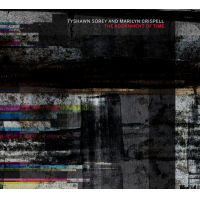 Tyshawn Sorey and Marilyn Crispell
Tyshawn Sorey and Marilyn Crispell The Adornment of Time
Pi Recordings
2019
Two of music's true geniuses, drummer-percussionist Tyshawn Sorey and pianist Marilyn Crispell, join forces on an extraordinary album. The Adornment of Time is a single-track project running almost sixty-five-minutes. The music was improvised and recorded live at the multi-purpose Greenwich Village club, The Kitchen. Sorey and Crispell are known for their exceptional ability to listen and to empathize with colleagues. These personal traits make this album a benchmark for immediate creativity.
The Adornment of Time with its narrative alternates from tranquil to boisterous to near silence. Crispell's playing is sometimes delicate, other times thunderous. She has the uncanny ability to create palpable tension without sacrificing the music's fluidity; it's a critical factor in an extended work of this nature. With an orchestra-sized drum kit, Sorey has stated that he doesn't have a particular style of playing. That freedom manifests itself in fragile passages with bells and gongs and booming eruptions.
Sorey and Crispell did not have a joint briefing session before the performance, a fact that makes the synchronicity remarkable. As these two innovators often do, they create outside any prominent genre but concentrate on many musical foundations. The audience is spellbound—silent for the entire piece; it's likely many listeners react the same way.
Tyshawn Sorey: drums, percussion; Marilyn Crispell: piano.
 Ayman Fanous and Frances-Marie Uitti
Ayman Fanous and Frances-Marie Uitti Negoum
Mode Records
2019
The very flexible tone systems of the Middle East and Southern Asia have influenced Western music for decades. From John Coltrane to Jimmy Page and George Harrison, those regions' sounds have often successfully fused with the disciplined beat of the West. Egyptian-born, New York-based guitarist and bouzouki player Ayman Fanous and American-born, Paris-based cellist Frances-Marie Uitti bring East and West together on Negoum but not in a predictable manner.
Fanous appears to be most comfortable in the company of string players. He has recorded twice as a co-leader, with cellist Tomas Ulrich on Labyrinths (Konnex Records, 2007), and with violinist Jason Kao Hwang on Zilzal (Innova, 2013). His performances include duos with William Parker, Mark Feldman, Ned Rothenberg, and Mat Maneri. The experimentalist Uitti is widely regarded as one of the most original cellists in modern music. She has developed an extended two-bow method that converts her cello into a rich polyphonic instrument. Uitti has collaborated with John Cage, Elliott Sharp, Mark Dresser and many others from the top tier of the avant-garde.
At more than sixteen minutes, the opening track, "Adhara," occupies a quarter of the album's length. With Fanous playing bouzouki and Uitti alternating between one bow and two, the piece conveys the melodic musical improvisation known as Taqsim in the Arabic-speaking world. Uitti adds elements of drone and Western melody to a frequently shifting soundscape. The duo paints a broad swath across the remaining tracks; Uitti coaxes raw, unnatural sounds from the cello on "Caph"; Fanous augments "Nekkar" with gentle flamenco passages. "Megrez," the other extended piece on Negoum, combines East/West folk rhythms, Western classical, and improvisation in a creative union of influences.
Ayman Fanous: guitar, bouzouki; Frances-Marie Uitti: cello.
Tags
Building a Jazz Library
Karl Ackermann
King Oliver
Jelly Roll Morton
oscar peterson
Ray Brown
Harry Edison
Roy Eldridge
duke ellington
Jimmy Blanton
Bill Evans
Jim Hall
John Coltrane
Rashied Ali
Joe Chambers
Larry Young
George Coleman
Tommy Flanagan
Hank Jones
Max Roach
anthony braxton
Binker and Moses
Binker Golding
Moses Boyd
Milford Graves
Bill Laswell
Peter Brotzmann
john zorn
Don Pullen
Andrew Cyrille
David Murray
Charlie Haden
Hampton Hawes
Ornette Coleman
pat metheny
Lyle Mays
Bobby Kapp
Matthew Shipp
Richard Wyands
Gene Perla
archie shepp
Noah Howard
Donat Fisch
Christian Wolfarth
Maciej Fortuna
Krzysztof Dys
tomasz stanko
Michal Urbaniak
Krzysztof Komeda
Marcin Wasilewski
Adam Makowicz
Rob Mazurek
nate wooley
Mal Waldron
Keith Jarrett
Kit Downes
Tom Challenger
Vijay Iyer
Wadada Leo Smith
Bob Gluck
Tani Tabbal
Sun Ra
Roscoe Mitchell
Oliver Lake
Muhal Richard Abrams
Henry Threadgill
Geri Allen
evan parker
Dewey Redman
Pauline Oliveros
Connie Crothers
Lennie Tristano
Susie Ibarra
Adam Berenson
Daoud Shaw
Paul Bley
Van Morrison
Jerry Garcia
Etta James
Scott Barnum
Don Byron
Aruan Ortiz
Satoko Fujii
Ramon Lopez
Alister Spence
Joe Fonda
Mark Feldman
Carla Kihlstedt
Natsuki Tamura
Tatsuya Yoshida
Tyshawn Sorey
Marilyn Crispell
Ayman Fanous
Frances-Marie Uitti
Tomas Ulrich
Jason Kao Hwang
William Parker
Ned Rothenberg
Mat Maneri
John Cage
Elliott Sharp
Mark Dresser
PREVIOUS / NEXT
Support All About Jazz
 All About Jazz has been a pillar of jazz since 1995, championing it as an art form and, more importantly, supporting the musicians who make it. Our enduring commitment has made "AAJ" one of the most culturally important websites of its kind, read by hundreds of thousands of fans, musicians and industry figures every month.
All About Jazz has been a pillar of jazz since 1995, championing it as an art form and, more importantly, supporting the musicians who make it. Our enduring commitment has made "AAJ" one of the most culturally important websites of its kind, read by hundreds of thousands of fans, musicians and industry figures every month.








